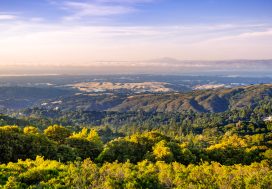Unless you’re well-versed in the world of plants, you may not be able to pick out which plants are native and which are not when you take a walk outside. After all, non-native plants have been coming to California since at least as far back as the 16th century, when European settlers were first exploring the area.
What exactly are native plants?
Native plants are those that have formed symbiotic relationships with native wildlife over thousands of years and provide a sustainable habitat for them, says the National Wildlife Federation. Native plants grow naturally in specific regions and ecosystems without being there as a results of human introduction.
Today, as we face environmental challenges on many fronts, native plants are making a comeback as owners and builders make decisions about how to landscape their properties. Native plants offer a variety of benefits that make them the perfect fit.
- Native plants are low maintenance.
By design, native plants have already adapted to the climate conditions of their geographical area, thus they have better odds of outlasting non-native species, and they require minimal care.
- They use less fertilizer and little to no pesticides.
Native plants have adapted to handle local pests and animals, as well as diseases. This means they generally won’t have to be sprayed with pesticides in order to stay healthy.
When we spray pesticides on our lawns, the runoff can contaminate rivers and lakes, in addition to coming into contact with people and pets.
Native plants generally require less fertilizer, which can also contaminate local waterways with phosphorus and nitrogen, causing excess algae growth, which harms aquatic life and interferes with recreational uses, says a study by Cornell University.
- They’re healthier for people and pets.
In the U.S., the average lawn uses more pesticides than are used in agricultural areas. As a rule, the less exposure you and your family have to toxins, like pesticides, herbicides, and artificial fertilizers, the better.
- They use less water.
Native plants have adapted to the average precipitation levels for their natural geographical areas. In California, where we undergo periods of drought, landscaping that requires minimal water can be a huge cost saver, and not to mention a time saver.| - Native plants support local birds, other wildlife, and biodiversity.
Native insects and birds have co-evolved with native plants, and they rely on them to survive and thrive, says the Audubon Society. Native plants provide nectar for pollinating insects, such as butterflies, bees, and moths, as well as for hummingbirds and bats. They also provide protective shelter for animals and insects.
- They’re not invasive.
According the Audubon Society, non-native, exotic plants can disrupt the food web, which enables invasive pests and other competing non-native species to degrade natural habitats.
- They cost less money.
Native plants might cost as much as exotic plants when you buy them in a nursery, but over time, they cost much less money to maintain. Areas where you save include on your water bill and on fertilizers, pesticides, and weed killers.
- They help fight climate change.
Native require little to now lawn mowing, which saves gasoline. According to the EPA, hour-for-hour, gas-powered lawn mowers produce 11-times as much pollution as a new car. With the average homeowner mowing their lawn 22 times per year, lawn mowers have a sizable carbon footprint. In addition, native trees, like California live oaks and redwoods, are especially efficient at absorbing greenhouse gases.
- They’re beautiful to look at.
In addition to all of these benefits, native plants are gorgeous to look at, and they smell great too. By including a variety of native plants around your property, in different sizes, shapes, heights, and colors, you’ll provide food and shelter for local wildlife and present a property that is truly in harmony with your location.
Resources
Here are a few resources that will help you find native plants for Silicon Valley and the San Francisco Bay Area:
Audubon Society Native Plants Database
Lady Bird Johnson Wildflower Center
Native Plant Library
Kristen M. Stanton is the founder and CEO of the eco-friendly living website UniGuide
Work with Silicon Valley’s Property Management Experts
Reduce your stress with Intempus Property Management, the greater San Francisco Bay Area’s leading property management firm. We’ve been serving satisfied clients for over 12 years with our full range of real estate and property management services. Contact us today to talk to one of our local experts. We look forward to serving you!




